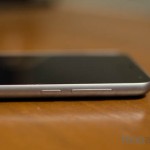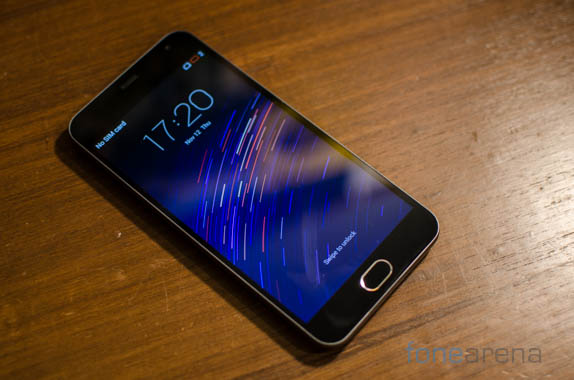
Ever since Meizu started operations in India, they’ve fast become a player to watch out for. While a significant market share still eludes the brand, they certainly have managed to carve out a niche for themselves by offering fantastic quality and overall experience. Indeed, the small but vocal fan following echoes exactly what we found out in our reviews. Meizu makes good phones that balance specifications versus price surprisingly well. With the launch of the Meizu m2, we really wanted to see if the company could continue it’s streak. Here’s the FoneArena review of the Meizu m2 and let’s take a look at how it fares.
Meizu m2 specifications
- 5-inch (1280 x 720 pixels) HD display with 1000:1 contrast ratio, AGC Dragontrail glass protection
- 1.3 GHz quad-core MediaTek MT6735 64-bit processor with Mali-T720 GPU
- 2GB RAM, 16GB internal memory, expandable memory up to 128GB with microSD
- Android 5.1 (Lollipop) with FlyMe OS 4.5
- 13MP rear camera with LED Flash, f/2.2 aperture, 5p lens, Gorilla Glass 3 protective lens glass
- 5MP front-facing camera, f/2.0 aperture, 4p lens
- Hybrid Dual SIM (second slot can also be used as microSD slot)
- Dimensions: 140.1×68.9×8.7mm; Weight: 131g
- 4G LTE / 3G HSPA+, WiFi 802.11 a/b/g/n (2.4GHz/5GHz), Bluetooth 4.0, GPS / GLONASS
- 2500mAh battery
Design
On the outside, the Meizu m2 looks very similar to practically every Meizu device out there. Some might call this boring or even lack of design diversity, we feel that it is an attempt to create a design identity that transcends price segments. Spin it any way, the design is visually appealing and ergonomically sound.
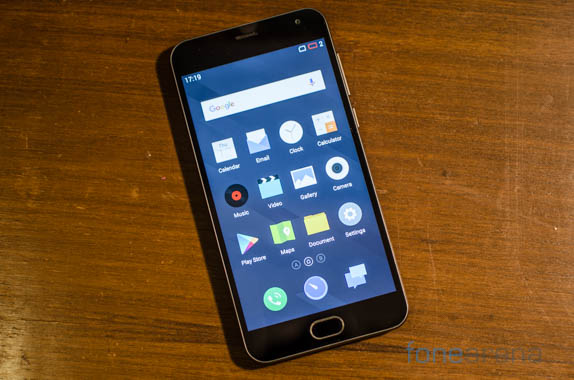
The front is tack sharp and absolutely flat with nary a curve. It fits in a 5 inch display that melds in beautifully with the black bezel surround the screen and creates a seamless black surface. There’s Dragontrail glass here for protection and the approximately 72% screen to body ratio certainly makes use of it.
The right hand side is where you find the power button and volume rocker above it. Both offer great tactile feedback. The SIM tray lies on the left. The tray houses both the SIM slots and the microSD card but we’ll talk about this later in the review. The top of the phone sports a 3.5mm audio jack while the bottom is where the micro USB port is located. Additionally, a speaker grille can also be seen here.
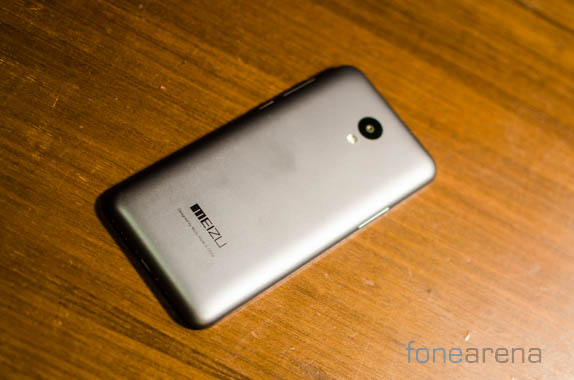
Flip over the handset and you can notice that the back of the m2 is extremely clean. The camera module is placed up top with a single LED flash below it. The Meizu logo is silkscreened right at the bottom. Below the logo, you’ll notice a curious statement that says,’Designed by Meizu, Made in China.’ This stands is testament to Meizu’s attention to detail and their aim to move away from being branded as yet another Chinese device. We’re inclined to believe that the company is proud to embrace its origin and is at the very least trying to show that Chinese companies too can create top notch hardware. As we mentioned earlier, the ergonomics on the phone are fantastic. While it is unfortunate that the metal looking back is actually plastic, it feels really good in the hand. We love how the edges curve around the back and fit really well in the palm. At 140.1 x 68.9 x 8.7 mm, the petite contours are a pleasure to hold and the 131 gram weight doesn’t hurt either. All in all, we feel that the handset delivers on the design front.
Software
Hardware and software work in tandem to create a compelling smartphone experience. Meizu’s Flyme operating system has been polarizing to say the least. The interface is anything but stock though we find the experience quite refreshing.
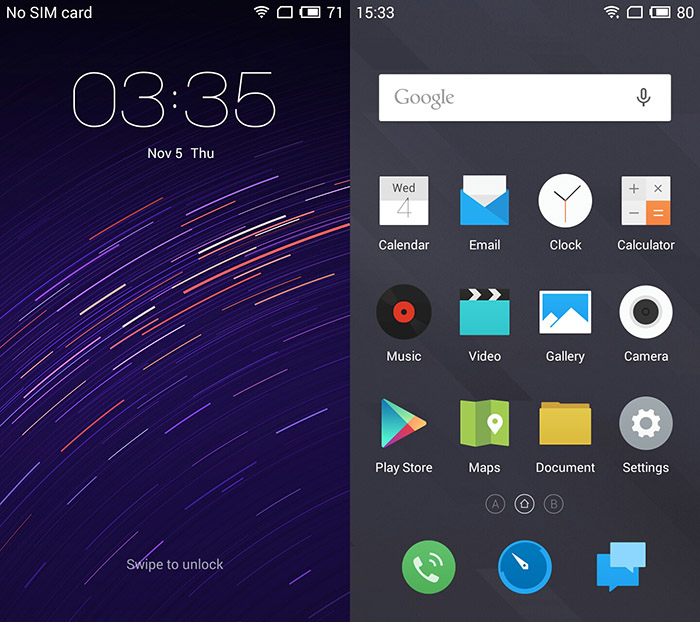
The lock screen is a simple affair and requires you to swipe to unlock as you’d expect. Nothing extraordinary there. Once you’re on the homescreen, you are greeted by crisp icons part of the Flyme UI. The interface eschews a dual level hierarchy and so places all icons on the homescreen itself.
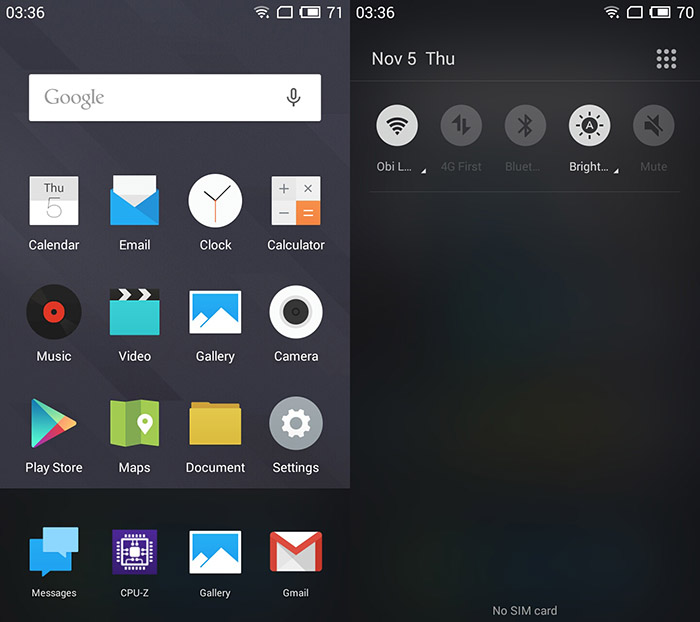
Changes run deep throughout the interface. The app switcher in particular is a peculiar modification and one that we’re not really fond of. Swipe up from either side of the home button and you are given access to the last few accessed applications. The notifications hub on the other hand is mostly the same with some tweaks.

It is possible to select the connected WiFi hotspot right from the lockscreen itself and some of the other toggles too can be adjusted. Step into the settings menu and you’ll likely be caught off guard. Reminiscent of Android’s tablet UI, this is a two pane set up and looks very cluttered. It can get confusing to use the settings menu especially the typography is entirely replaced by iconography. Nonetheless, there is some good here too like the about section as shown above which points out all the essentials at a glance. Really though, the entire usage experience is an acquired taste. Given that the phone combines the back button and home button into a single touch/tap paradigm, there’s really no way to say that this will work for you till the time you’ve actually tried it out. On our part, we kinda like the clean look but feel that there are some changes that appear to be tacked on for no reason whatsoever.
Performance
You’re looking at the wrong device if you are expecting a powerhouse here. Powered by a 1.3 GHz quad-core MediaTek MT6735 64-bit processor with Mali-T720 GPU and paired with 2GB of RAM, the specifications on offer are totally run of the mill. Hardware alone doesn’t make for great performance. Excellent software optimization on the Meizu m2 means that for regular day to day usage you’d be hard pressed to find it lacking. Most games too work well enough though frame drops do occur here and there. As long as you keep the multitasking and by extension, your expectations in check, you really won’t find the Meizu m2 disappointing. We’ve included a couple of synthetic benchmarks as well for your perusal.
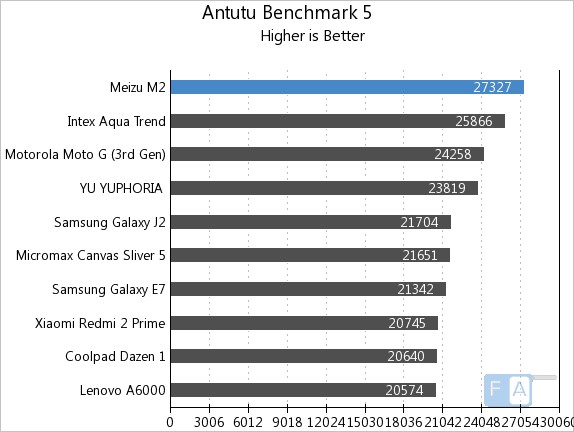
In the AnTuTu benchmark, the handset tops the competition with a score of over 27,000 points.

The Quadrant benchmark on the other hand proves to be a challenge for the handset where it scores just 11358 points. A middle of the range number by all accounts.
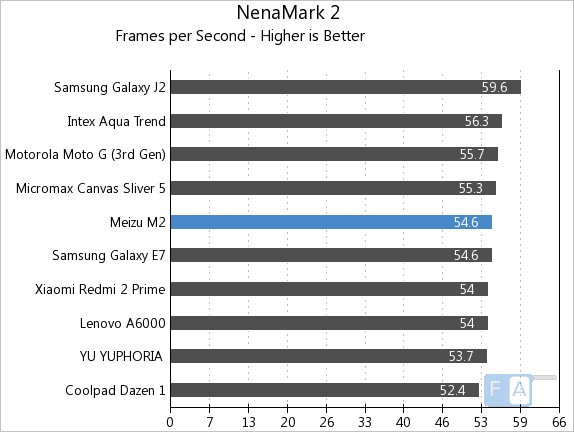
In the GPU centric NenaMark benchmark, once again the handset scores numbers that are right in line with other handsets from this category. As we mentioned earlier, performance here isn’t extraordinary. In fact, the consistently decent performance on offer is what makes this device compelling.
Display
Asahi Dragontrail glass covers the 5 inch 720p display on the handset. The screen is sharp and has natural looking colors. We can’t really complain about the neutral signature of the images that a few of you might find rather muted and erring on dull. A contrasty Super AMOLED panel this is not.
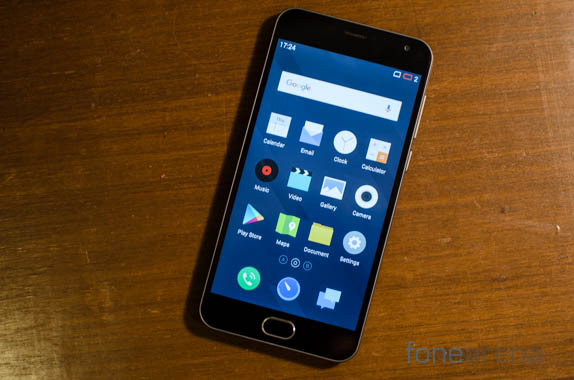
Brightness levels too leave a bit to be desired. While the display is certainly visible outdoors, a higher maximum brightness level would’ve made it a bit more comfortable experience. All in all, the display is satisfactory but not quite as good as the competition and is certainly something that could do with a bit of improvement.
Camera
The Meizu m2 is equipped with a 13MP rear facing camera that is still somewhat rare in the category. Additionally, you’ll find a 5MP front facing camera too. While the handset isn’t a camera flagship by any stretch of the imagination, daylight shots are reasonably good.
Low light photographs on the other hand lack detail with grain being prominent across the spectrum. This is of course par for the course for budget handsets.
The phone can capture Full HD video that looks good enough when shot in well lit conditions.
Connectivity
In terms of connectivity, the Meizu m2 is equipped with 4G LTE / 3G HSPA+, WiFi 802.11 a/b/g/n (2.4GHz/5GHz), Bluetooth 4.0, GPS and GLONASS. It is really unfortunate that the phone follows the recent trend of having a hybrid SIM card slot. This means that the secondary card slot can either be used for the SIM card or as a microSD slot. Given that the handset ships only in a 16GB configuration, unless your storage requirements are minimal you’ll probably be using this as a single SIM device. That said, of the 16GB storage there’s about 10GB available and you can use USB OTG as well.

In terms of battery life, we achieved screen on time of over 5 hours and a full work day of usage. Our usage involves multiple email accounts configured and extended social usage as well as quite a few phone calls. With average usage, standby time should stretch over a day for you.
Conclusion
The Meizu m2 isn’t a perfect smartphone but it is still a very good smartphone indeed. From great build quality to excellent audio playback, battery life, there’s a lot to like here. Performance on the other hand is somewhat middling but then the well optimized software makes up for it.

We found the display to be somewhat muted with brightness levels that felt a bit lacking. All in all, the Meizu m2 wasn’t the sure shot hit that we expected it to be. We would still recommend the Meizu m2 as a strong contender in the sub Rs. 10,000 segment but you’d be well served to try out the CoolPad Note 3 as well before you invest in the handset.The Meizu m2 is priced at Rs. 6,999 in India.
Pros
- Software optimization
- Audio quality
- Battery life
- Build Quality
Cons
- Brightness levels
- Camera
- Software UI
- Average performance


